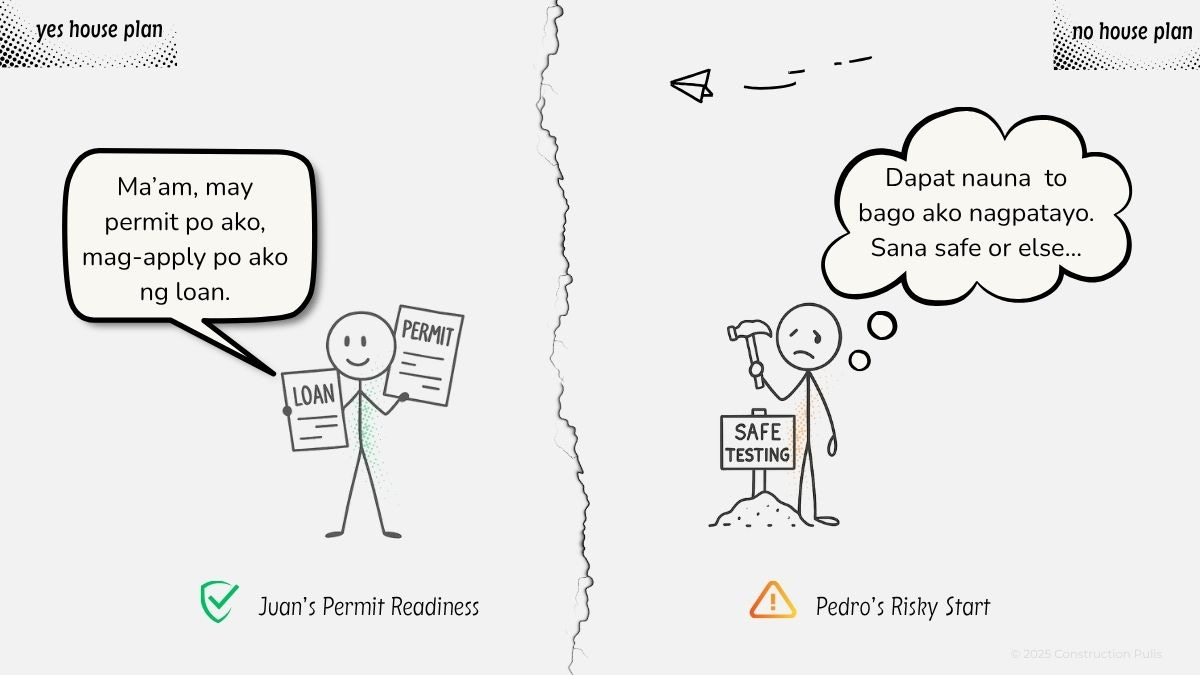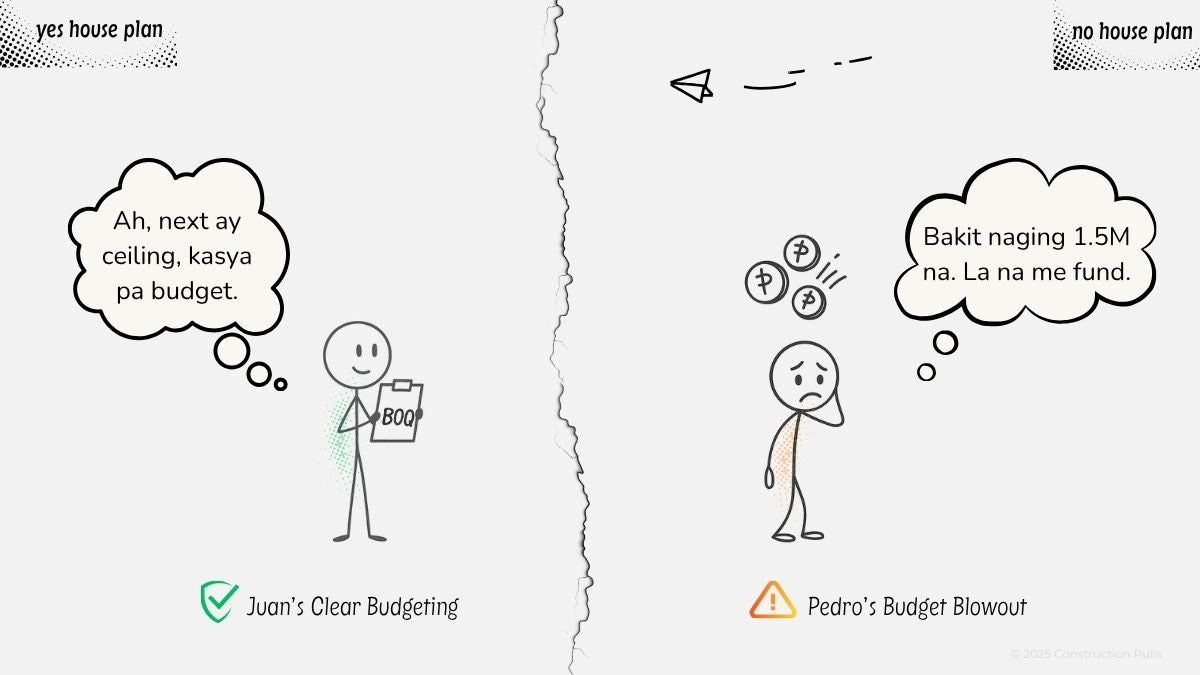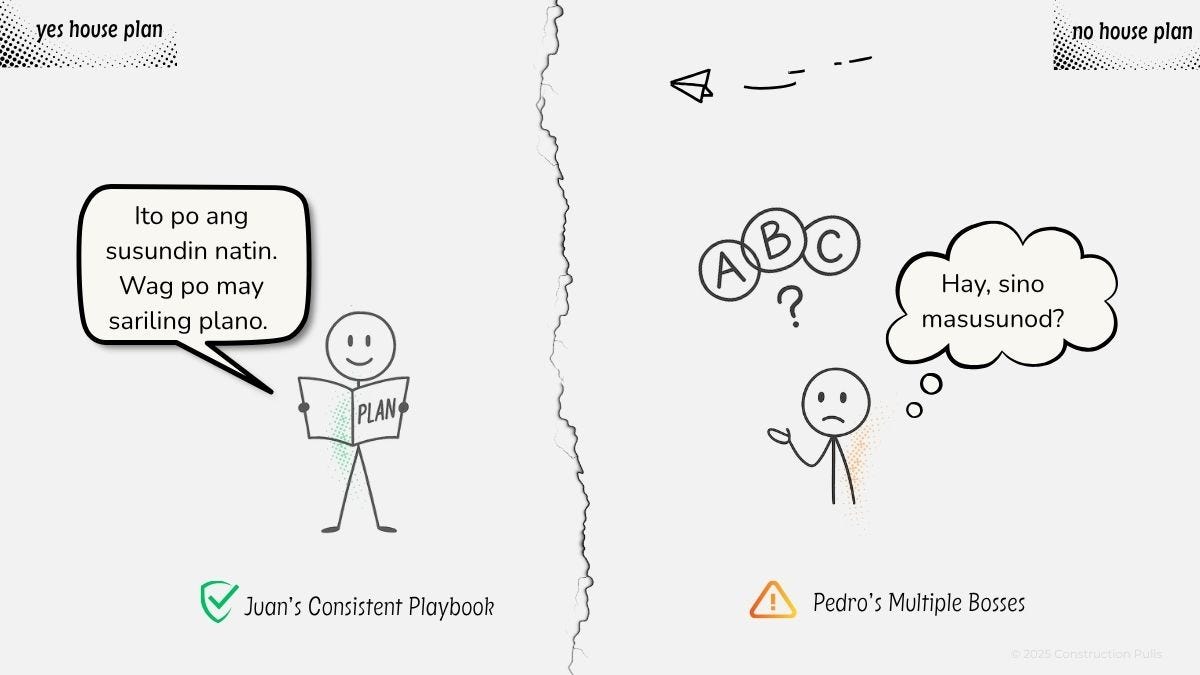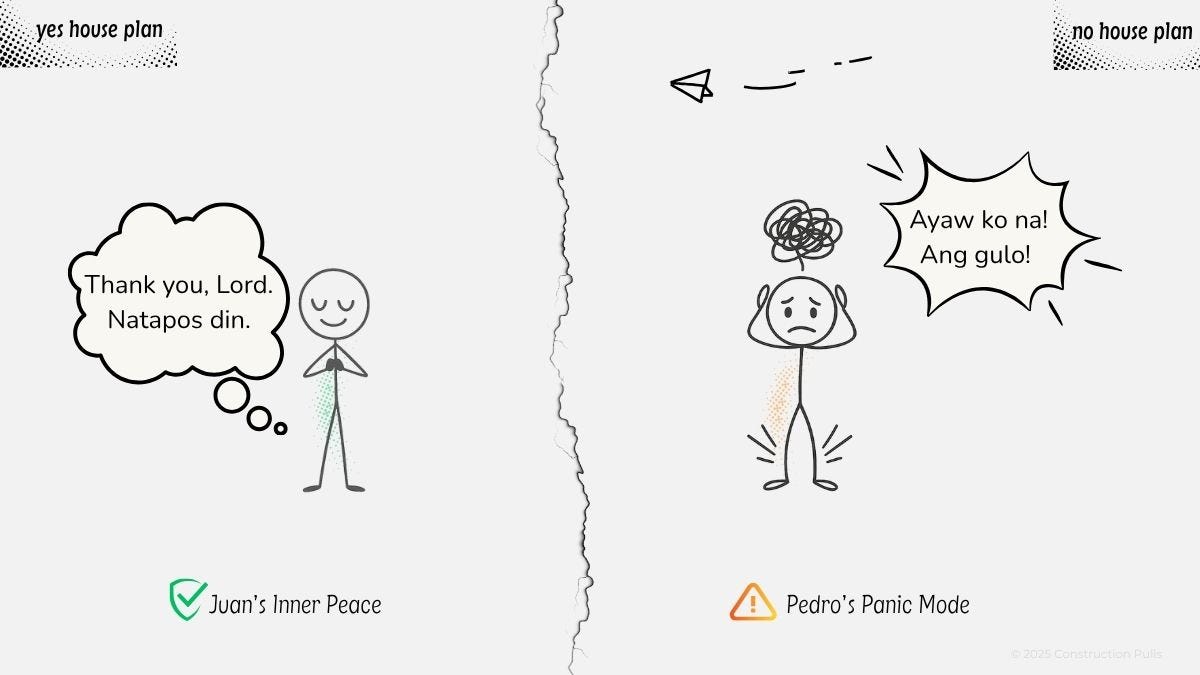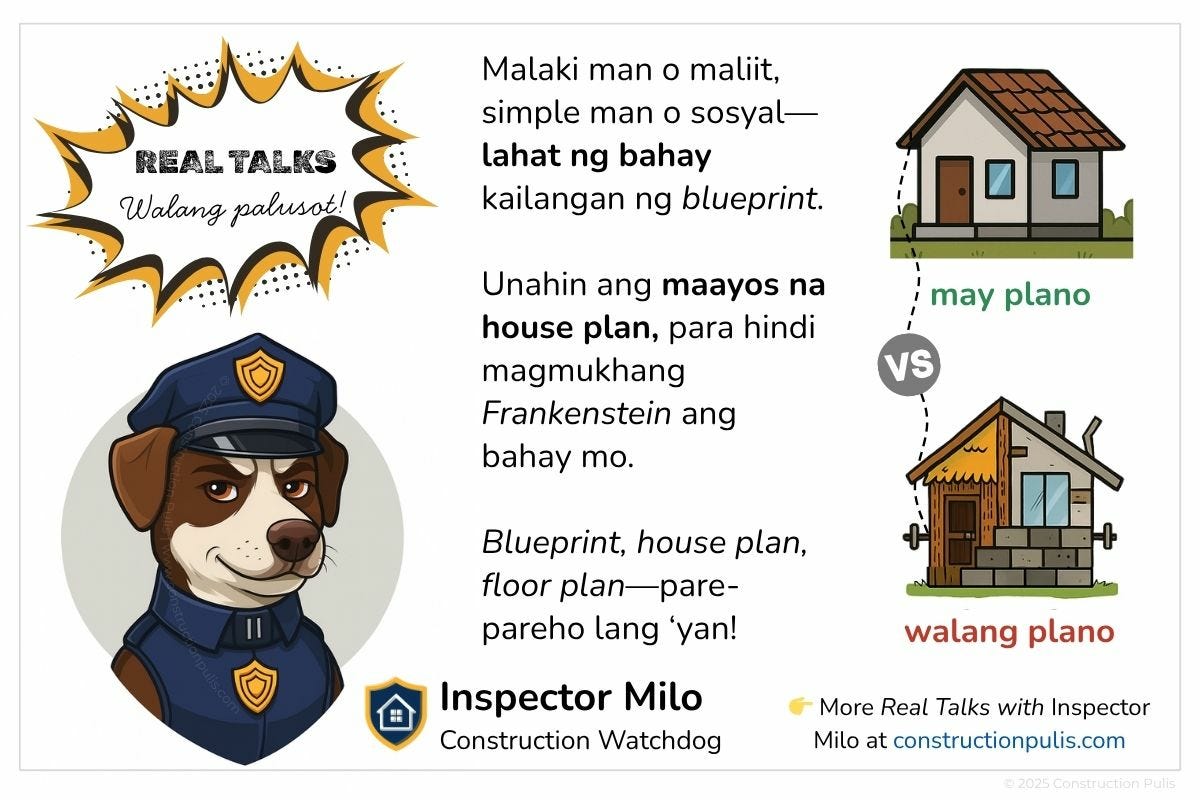In my first two Dispatches, I told you about the engineer who scammed us and those seven questions I should’ve answered first. I mentioned the blueprint, but I didn’t emphasize how critical it is. The blueprint is the DNA of your build.
Meet Juan and Pedro. One has a plan, the other wings it. Below, you’ll see exactly how their journeys unfolded and where I fit in. Spoiler: I was Pedro.
I don’t want you to be like Pedro, so let me be repetitive here. The plan is your 100% priority, and everything else follows.
1. Juan walks in with his documents ready. Pedro skips steps and hopes for the best.
Pedro rushes to pour concrete without checking if the soil can support it. He skips proper safety checks. This is the very reason many houses end up abandoned or demolished.
Juan won’t compromise on this. He won’t start building until he sits with a professional to create his plan. That means he’s got permits sorted and documents ready if he needs a loan.
Dad and his crew were undeniably Pedros.
Our house construction started without safety checks. We got lucky—when we eventually got a blueprint and applied for permits to avail a Pag-IBIG loan, the land didn’t have structural issues. Construction could proceed.
But luck shouldn’t be part of any homeowner’s safety plan. One way or another, things will go wrong, and building without a blueprint is just the beginning.
2. Juan knows where every peso goes. Pedro watches his savings vanish and has no idea why.
Pedro has no plan, which means no BOQ. Costs spiral as he keeps adding, adjusting, and re-buying materials. That ₱1M budget? Biglang ₱1.5M.
Juan, with a BOQ, has a baseline. This helps him keep his budget realistic. He knows what materials are needed. If construction pauses, he can review his BOQ to identify the next essential work and save for it before resuming.
The way we handled money? Pure Pedro.
From the beginning, we spent Dad’s savings, my savings from China, a loan from my aunt, and eventually a Pag-IBIG loan. All of which vanished without us knowing exactly where they went. We kept proceeding without reviewing things.
Fast forward to the engineer. When he gave me a BOQ, I didn’t double-check or verify anything. This time, we got a finished first floor, but part of our savings vanished in a scam along the way.
Juan’s constant review of his plan and BOQ doesn’t just prevent budget blowouts. It’s his protection against scams. We should have done the same.
3. Juan’s crew follows one plan. Pedro’s crew waits for someone to decide who’s in charge.
Without a plan, Pedro has multiple bosses. Everyone insists on their own version or ideas. Even when Pedro eventually gets a plan, people ignore it and do what they want anyway. The people he hired became the decision-makers by default. He handed them control because he’s too exhausted to think about who should be followed.
Juan does it differently. His blueprint serves as a single reference point even if he plans to change engineers, contractors, or workers. Everyone follows the same playbook, so less confusion and fewer mistakes.
Dad and I? Still Pedros.
In 2015, my family had different opinions on how the construction should go. They’d been arguing, but Dad always won. He made sure the family followed his decisions over what the blueprint said. Yet when it came to his contractor, he flipped. He said yes to everything, even when the contractor pushed to maximize space and ignored the 2-meter boundary rule.
When the engineer came in 2025, I thought: finally, relief. No more family arguments. We had an expert.
But I went too far. I made him the only boss. He handled everything: the planning, the money, the workers. All of it. That’s too much control with zero checks. I created the perfect setup to scam us.
For Juan, his plan is the boss, not any single person. Everyone follows the blueprint and BOQ, including Juan himself. Not their own ideas.
4. Juan sleeps well. Pedro is drowning.
Juan has peace of mind. He knows where his money goes, trusts his plan, and has prepared extra funds for emergencies. When something doesn’t go as planned, he reviews his BOQ and adjusts accordingly. No panic, no desperation.
Pedro is drowning. He’s anxious and lost in the numbers. Every delay feels heavier because there’s no plan to fall back on. He’s not just building a house anymore. He’s trying to survive it.
I remember sitting at the back pew of a church, praying about the Blue Building.
I prayed, if only buildings could be like a drawing on paper, where I could crumple and start all over again if my drawing is wrong or ugly. Nope.
Or what if I abandon this project, find myself a nice place, and let that Blue Building be just that? Okay, that’s selfish.
But there’s no way this Blue Building will take my Japan savings too, not after everything it had already consumed.
I honestly didn’t want to continue and feared all my what-ifs. We were drowning like Pedro and needed help, so I hired the engineer.
Yet instead of throwing us a lifebuoy, he let us sink even deeper.
The stress of building without a plan was hard enough. But to be scammed despite him knowing our story and struggles? Devastating.
So Which One Are You?
By the time I finally saw the full picture, I’d already sent 90% of the first-floor budget. The ‘cracks’ I mentioned in my Open Letter weren’t accidents. They were the ripple effect of building without a plan from the start. If Dad and his crew had followed one, I would’ve known what to look for when it was my turn. But the engineer spotted the Pedro pattern and knew exactly how to exploit it.
Scammers don’t target people who plan and verify. They target people in panic mode who just want someone to “handle it.”
Juan’s story isn’t luck. It’s what happens when you do the boring work upfront. Measure twice. Research prices. Clarify who’s in charge. Follow the plan. Juan did his homework.
Let’s not be a Pedro. Be a Juan.
How to Actually Get That Plan
So how do you secure a blueprint? Here’s exactly what to do based on where you’re at right now.
Scenario 1: If you can afford an architect or engineer and know what you want
Don’t just rely on “kakilala lang.” Ask for their portfolio. Review their previous designs and, if possible, visit houses they’ve actually completed. Bahala na kung matawag kang “ang kulit naman nito” or “ang nosy.” Your money, your house, your design, your questions.
Ask the hard questions:
Are you PRC-licensed? Can I see your previous work or portfolio? What’s included in your service: drawings only, or do you also supervise construction? How many revisions are allowed before extra charges apply? How much is your fee, and what percentage of the total project cost does it represent? How do you handle payments, per milestone or full upfront? What’s the usual timeline for design approval?
Critical: Don’t wait until the design is finished before asking about costs and terms. Ask early, clarify everything, and get it in writing.
You’re paying for expertise, and it’s not cheap. In the Philippines, the architectural or design fee usually ranges from 6% to 12% of your total construction cost, depending on the project’s size and complexity. For a ₱4 million build, 8% would be around ₱320,000. Simpler designs may cost closer to 5-6%, while larger or high-end projects can go above 10-12%.
Pro Tip: A good professional explains their design clearly and welcomes your questions. Avoid anyone who makes you feel rushed or dismissed.
But some homeowners think they can skip professionals altogether. I strongly discourage that.
Scenario 2: If you can afford professionals but think you don’t need them
You want to “save costs” or try to DIY everything. Reconsider. Professionals exist for a reason: their expertise protects your investment.
Yes, some professionals are scammers (I learned that the hard way). That’s why you verify credentials, check portfolios, and never give one person total control. The solution isn’t to skip professionals.
Let’s not forget that amidst the flood of fraud, there are still many honest builders out there who are experts with integrity. We need their services. Once you find one, pay them right.
Don’t let scammers make you distrust everyone. Fair payment for honest builders keeps them in business.
Scenario 3: If you’ve already started your build without a blueprint and you’re doing renovations now
If you’re already mid-build and realize you’ve been Pedro this whole time, it’s not too late. Start with what you can control right now.
The blueprint doesn’t need to be like the one made for houses built from scratch. You can’t just demolish everything and start over, right? So work with what you already have. Get a basic floor plan drawn, then coordinate with a contractor to create a completion plan. It should show you how to finish the remaining work, where to adjust, and which parts, if any, need demolition to make it right.
Watch out when a contractor or engineer insists on demolishing or redesigning parts that are still functional just for “visual consistency.”
In my case, our dishonest engineer once suggested demolishing half of the third-floor wall so it would match the second floor’s design. The second floor had a balcony, and the third floor had that same area enclosed. When he said, “No, it won’t affect the structure,” my first thought was, “That’s easy to say if you’re not the one paying.”
We already had several issues with the building, and the last thing I wanted was unnecessary demolition. The wall was fine.
Some professionals think about how a project will look or how convenient it is for them, without considering the financial strain on the homeowner. If it were their house, would they really tear that wall down?
Good professionals who truly care will suggest only what your renovation actually needs, not what will make them earn more. So the next time someone suggests a change, don’t just agree right away. Ask yourself, “Is it really necessary?” or “Are there other ways to make it work?”
The goal is to finish within a reasonable budget. If changing something is expensive and purely for looks, let it go. Accept that as the consequence of not starting with a plan.
Scenario 4: If you’re on a tight budget, it’s not an excuse to skip the plan
If you can’t afford a full-service architect, you’re probably not ready to build yet. Go back to answering the seven questions from Dispatch 2.
But they’re not your only option. You just need to use resources that fit your budget. Here are some affordable house design ideas to get clear on your vision:
Note: These are options I’ve researched to show what’s available. I haven’t personally used all of them, so do your own due diligence before choosing what works for you.
1. Ready-Made Plans – Buy affordable, off-the-shelf designs
If you prefer a standard house design without heavy customization, ready-made plans are ideal. I contacted Pinoy ePlans to get current pricing. Here’s what they quoted (as of 2025):
One-storey homes:
Blueprint Package: ₱20,000-₱30,000
PDF Package: ₱10,000-₱15,000
CAD Package: ₱15,000-₱20,000
Two/three-storey homes:
Blueprint Package: ₱50,000-₱80,000 (includes PDF for free)
PDF Package: ₱25,000-₱40,000
CAD Package: ₱30,000-₱50,000
Learn more: Pinoy ePlans Package Descriptions | How to Order
Before ordering, check reviews from people who’ve actually used ready-made plans. Apply the same questioning from Scenario 1—ready-made doesn’t mean you skip being thorough. Some plans come with structural and electrical layouts, while others are purely architectural drawings. Clarify everything upfront.
2. Free Communities – FB groups, blogs, and YouTube builders
These communities share layouts, 3D models, and practical strategies. Take advantage of free house designs to get ideas on how you want your home to look and function.
If you find one that suits your needs, show it to a contractor and see how you can adjust it based on your lot area, number of rooms, window sizes, or that dirty kitchen you want to add.
3. DIY Tools & Apps – Try SketchUp or even The Sims to visualize your layout
Get creative. If you have time to learn these DIY tools, they’re worth exploring. You might discover you’re better at design than you thought. Just make sure to check with a professional to confirm if your layout is feasible for actual construction.
When a design is already simulated in an app, it’s easier for both you and your contractor to understand each other before turning it into a blueprint.
The Bottom Line
Your blueprint isn’t just step one. It’s the foundation everything builds on.
Exactly, Inspector Milo!



